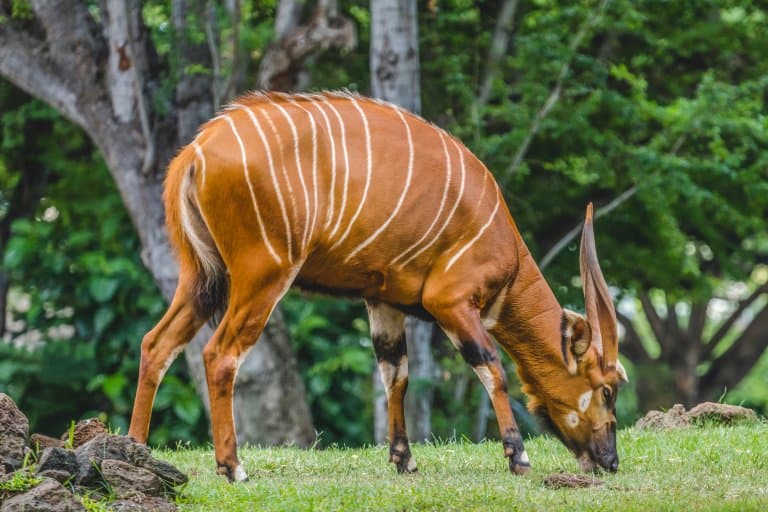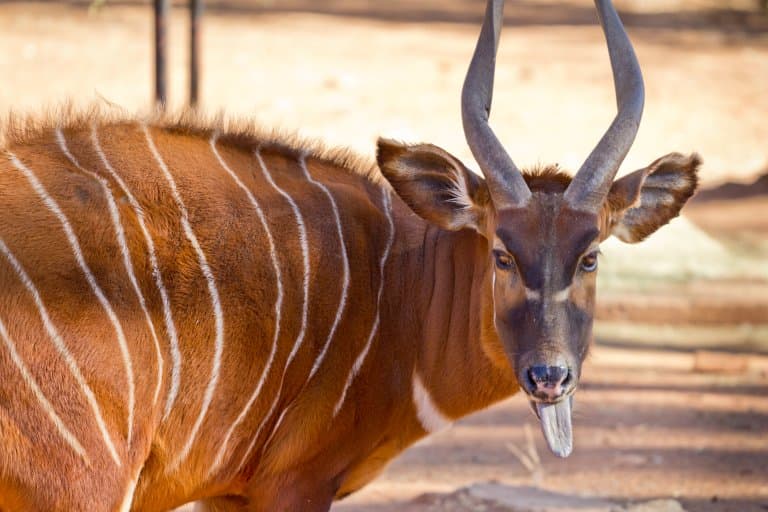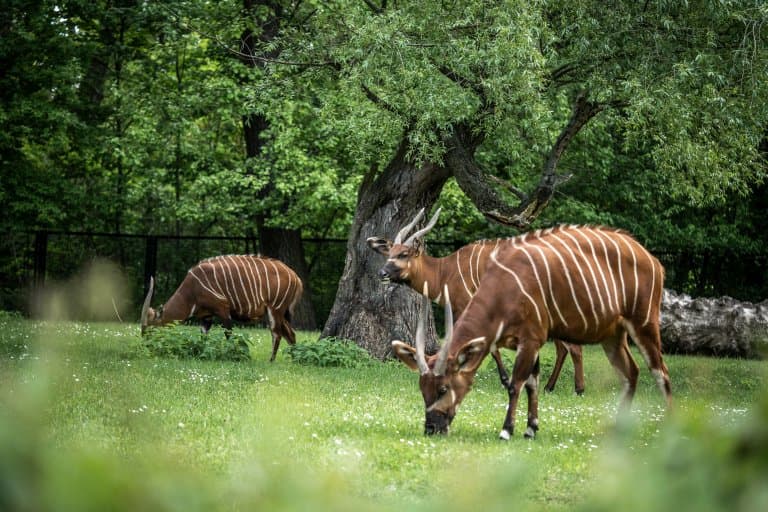Bongo Profile
The bongo is a large, colorful forest antelope with a distinctive red chestnut coat, patterned with bold white stripes traversing its body from the base of the neck to its back end.
They have heavy, spiral horns that can grow up to 1m in legnth and slope over their backs.
The Bongo’s distribution in Africa is fairly fragmented, but spans from Sierra Leone in West Africa through to Central Africa and East into Sudan and the more mountainous areas of Kenya.

Bongo Facts Overview
| Habitat: | Dense, tropical forests |
| Location: | The central belt of Africa, from West to East (although in fragmented areas) |
| Lifespan: | 21 years (in captivity) |
| Size: | 1-1.3 m in height, 2-3 m in length |
| Weight: | 150 – 400 kg (331 – 893 lb) |
| Color: | A reddish-brown coat with off white striped marking (12-14 stripes) |
| Diet: | Leaves, bushes, bark, vines, grasses, roots, fruit, bamboo in some areas |
| Predators: | Leopards, hyenas, humans |
| Top Speed: | 43 mph |
| No. of Species: | 1 (2 subspecies) |
| Conservation Status: | Near Threatened |
The head, neck, chest, undercarriage and legs are usually a slightly darker shade of auburn. Generally males are a few shades darker in color than the females and although both sexes have horns being of roughly the same length, the females are typically thinner and straighter.
Bongos are mostly nocturnal, however they can be seen during the day, most likely at dawn or dusk. When it is raining heavily, bongos remain relatively inactive and take cover in dense undergrowth.
They are usually found near abundant year round water sources. As they are large, they require a lot of food that grows consistently. Like most forest ungulates, they are herbivorous and will diet on leaves, bushes, grasses, roots, herbs and fruits,.
Bongos form herds and these can range from groups as small as 5 individuals up to as large as 50 individuals (although larger groups are more rarely seen). Bigger groups usually contain calves and smaller groups are usually only adults.
Groups tend to be made up of females and their offspring and males are found to be more solitary. This said, some herds have been observed to contain both sexes, including more than one male. It is thought that in more female orientated groups there is a hierarchical system where more senior cows lead the group.
The main predators of bongos are hyenas and leopards. Lions have also been known to prey upon this antelope and even pythons have been recorded consuming calves. Mothers will defend their young avidly and have been seen charging hyena and even a forest hog when threatened.
Sadly there has been a rapid decline in the bongo population over the last few decades due to habitat destruction, human settlement expansion and poaching.
It’s estimated there are around 28,000 bongo left in the wild today and their conservation status is currently classified as ‘near threatened‘ by the IUCN.
Interesting Bongo Facts
1. Both sexes have horns
Although both males and females having horns is common in many antelope, bongos are one of only a few species in the genus tragelaphus, where both sexes have them.
While they both have heavy spiral horns, the males horns are typically much larger. 1

2. They are the third largest antelope in the world
Bongos are smaller than both the common and greater eland, however they are larger than the greater kudu. 2
3. The bongo’s stripes help conceal them
When a bongo is trying to hide from a predator, its stripes actually help. They make their outlines less distinct, thus a predator will find it more difficult to pick an individual out.
4. The Eastern bongo is darker than the Western bongo
This sub-species have been seen to be nearly black in colour in some cases. In both sub-species however, a males coat gets considerably darker with age.
5. They do not have any special secretion glands
Many antelope species have secretion glands which help them locate one another and show where they are. Bongos do not have these and therefore it is thought that they do not rely so heavily on scent to locate each other.
6. They visit salt licks
Bongos will often visit salt lick areas, very much like elephants do. This activity is regularly completed at night and in the same area they will also graze on foliage too. Bongos have also been seen to eat soil and even burnt wood to get certain minerals.
7. They have prehensile tongues
Bongos can clasp leaves by wrapping their tongues intricately around them and pulling them off the branch.

8. They can raid plantations
Bongos are known to carry out crop raiding and have been reported to venture into farming areas where cassava, coco and yams are being grown. This has a negative impact on the relationship between bongos and the people living in the areas in which this occurs.
9. The gestation period is nearly the same as humans
After fertilization, the gestation period for a bongo is around 282-285 days, which is approximately 9 month. After this time, the female will usually give birth to one offspring, occasionally two. 3
10. Young calves play together
Calves often find themselves together in groups. They have been seen licking one another and also playing; practicing some of the moves that their parents show such as head shaking/throwing and neck fighting.

11. Horns begin to show early
Bongo calves grow pretty quickly, even their horns begin to show when the calves are between only three and four months old. Also weaning ceases at around six months of age.
12. Bongos become less shy in groups
On the whole, bongos are timid animals but when they form bigger groups, this shyness seems to lessen, with a sense of safety being felt in a larger group.
13. Bongos use body language to communicate
Adult bongos are not very vocal when communicating.
Calves will bleat for their mothers and bulls have been known to make grunting and snorting noises, especially when trying to attract females.
Most of their communication is done with their body postures/positions and generally carried out by the males.
14. Herd conflict is rare
When they want to show dominance they will often rub their horns on the ground or against other objects and break branches which indicates that they are a threat.
Fighting between bongos is seen to be pretty rare, however they have been known to carry out neck-fighting, head-butting and pressing each other with their fronts.
Submissive behaviours can involve keeping their head lower than normal, kneeling, twining their necks around each other and licking.

15. The Eastern or mountain bongo is considered critically endangered
This sub-species is found in a few mountainous areas of Kenya, with numbers extremely low – estimated to be below 140 in total.
There are said to be more of them found in captivity compared to the wild. 4
Bongo Fact-File Summary
Scientific Classification
| Kingdom: | Animalia |
| Phylum: | Chordata |
| Class: | Mammalia |
| Order: | Artiodactyla |
| Family: | Bovidae |
| Genus: | Tragelaphus |
| Species Name: | Tragelaphus Eurycerus |
Fact Sources & References
- Richard Despard Estes (1997), “The Behaviour Guide to African Mammals”, Russel Friedman Books.
- “Bongo-Meet an astute antelope species”, WWF.
- Kwaku Brako Dakwa (2014), “Density and distribution of bongos (Tragelaphuseurycerus) in a high forest zone in Ghana”, Research Gate.
- Merel Koopmans (2021), “Wild bongo density estimation and population viability analysis improves conservation management”, Science Direct.
